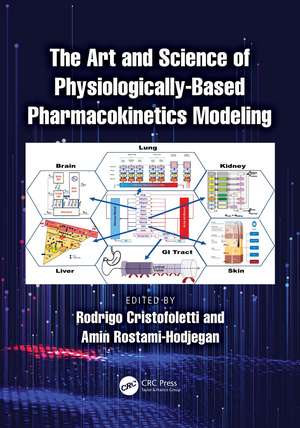The Art and Science of Physiologically-Based Pharmacokinetics Modeling
Editat de Rodrigo Cristofoletti, Amin Rostami-Hodjeganen Limba Engleză Hardback – 15 iul 2024
Features:
1. Provides a basic understanding of the physiologically-based pharmacokinetic modeling and its applications
2. Assists the reader in understanding product performance to allow for rapid product development and establish bioequivalence
3. Well-constructed content and added value of real examples
4. Illustrates how using available resources via modeling and simulation leads to a reduction in the costs related to drug development, which directly affects the costs to patients
Preț: 802.88 lei
Preț vechi: 845.13 lei
-5% Nou
Puncte Express: 1204
Preț estimativ în valută:
153.66€ • 159.99$ • 129.86£
153.66€ • 159.99$ • 129.86£
Carte tipărită la comandă
Livrare economică 10-24 martie
Preluare comenzi: 021 569.72.76
Specificații
ISBN-13: 9780367468873
ISBN-10: 0367468875
Pagini: 356
Ilustrații: 212
Dimensiuni: 178 x 254 x 28 mm
Greutate: 1.03 kg
Ediția:1
Editura: CRC Press
Colecția CRC Press
Locul publicării:Boca Raton, United States
ISBN-10: 0367468875
Pagini: 356
Ilustrații: 212
Dimensiuni: 178 x 254 x 28 mm
Greutate: 1.03 kg
Ediția:1
Editura: CRC Press
Colecția CRC Press
Locul publicării:Boca Raton, United States
Public țintă
Academic, Postgraduate, Professional Practice & Development, and Undergraduate AdvancedCuprins
1. From A Mathematical Model to a Technology, the 100 Years’ Evolution of PBPK
2. Basic principles of PBPK modeling and simulation
3. Oral Drug absorption in special populations: in vivo – in vitro – in silico evaluation
4. Physiologically based absorption models for complex formulations and dosage forms
5. Perfusion and permeability-limited distribution models
6. Modeling drug metabolism and excretion
7. Platform Qualification and Model verification
8. Applying PBPK modeling to predict drug-drug interactions
9. Applying PBPK modeling to predict drug exposure in special populations
10. PBPK-based Virtual Bioequivalence Trials to Guide Drug Development
11. Application of PBPK modeling to support clinical pharmacology regulatory decision-making
12. Physiologically based biopharmaceutics modeling (PBBM) in support of drug product specifications and biowaiver
13. Integrating PBPK modeling and Organ-on-a-chip systems to inform drug development
2. Basic principles of PBPK modeling and simulation
3. Oral Drug absorption in special populations: in vivo – in vitro – in silico evaluation
4. Physiologically based absorption models for complex formulations and dosage forms
5. Perfusion and permeability-limited distribution models
6. Modeling drug metabolism and excretion
7. Platform Qualification and Model verification
8. Applying PBPK modeling to predict drug-drug interactions
9. Applying PBPK modeling to predict drug exposure in special populations
10. PBPK-based Virtual Bioequivalence Trials to Guide Drug Development
11. Application of PBPK modeling to support clinical pharmacology regulatory decision-making
12. Physiologically based biopharmaceutics modeling (PBBM) in support of drug product specifications and biowaiver
13. Integrating PBPK modeling and Organ-on-a-chip systems to inform drug development
Notă biografică
Rodrigo Cristofoletti, Ph.D., is Assistant Professor of Pharmacometrics and Systems Pharmacology and Associate Director of Centre for Pharmacometrics and Systems Pharmacology, University of Florida, USA.
Amin Rostami-Hodjegan, PhD, FCP, FAAPS, FJSSX, FBPS, is Professor of Systems Pharmacology and Director of Centre for Applied Pharmacokinetic Research (CAPKR), University of Manchester, UK and SVP of R&D, Chief Scientific Officer (CSO), Certara, Princeton, USA.
Amin Rostami-Hodjegan, PhD, FCP, FAAPS, FJSSX, FBPS, is Professor of Systems Pharmacology and Director of Centre for Applied Pharmacokinetic Research (CAPKR), University of Manchester, UK and SVP of R&D, Chief Scientific Officer (CSO), Certara, Princeton, USA.
Descriere
This state of the art text describes the science behind the system and drug-dependent components of PBPK models, its applications in translational and regulatory science e.g. guiding drug discovery and development, and supporting precision medicine initiatives.
